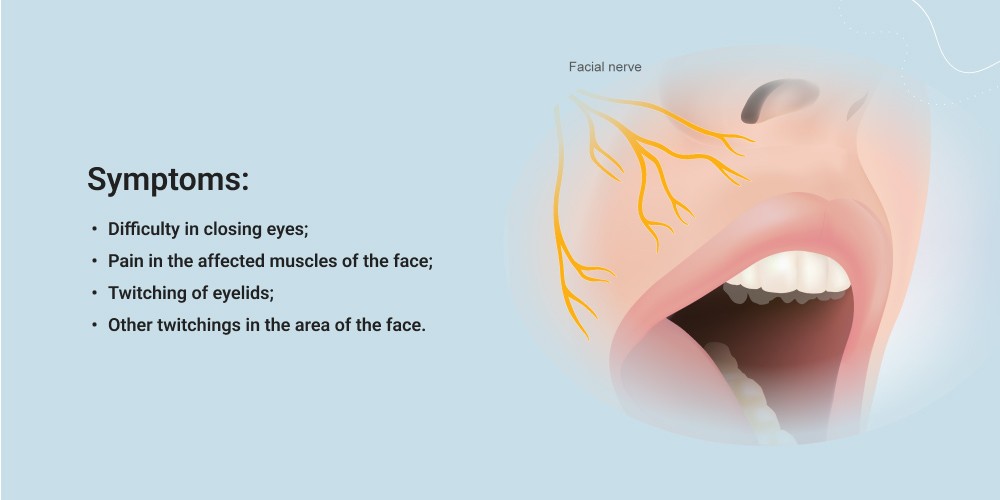The beauty of the face is essential for every person. We communicate, read emotions and other signs on a person’s face, and also express our emotions with the help of a face. The facial nerve is responsible for the work of our muscles on the face. However, at some point, this nerve can operate incorrectly. As a result, spasms in the face may develop.
Hemifacial spasm is unilateral painless synchronous facial muscle contractions due to repetitive, involuntary electrical impulses of the 7th cranial (facial) nerve and/or its motor nucleus. This disease is a rather serious problem that can change a person’s life, leading to discomfort and depression. It is vital to start timely treatment to improve the condition.
In our article, we will look at what twitching in the face is, what causes it, and the general symptoms of hemifacial spasm by which you can distinguish it.
Hemifacial Spasm Overview
Hemifacial spasm (HFS, also known as tic-convulsive) is an uncontrollable twitching of the facial muscles on one side of the face. The facial muscles (facial muscles) are controlled by the facial nerve (seventh cranial nerve), which originates in the brainstem and exits the skull below the ear, where it divides into several main branches. These branches run along the face, reaching the mimic muscles. The facial nerve is an exclusively motor nerve, meaning it contains fibres dedicated only to muscles. This nerve sends commands to the muscles that move the eyebrows, eyelids, mouth, and lips, and the platysma in the neck.
Irritation of the facial nerve causes abnormal electrical impulses within the nerve, which propagate along the nerve fibres and go to the muscles. Once a muscle receives an abnormal signal, it contracts, causing visible twitches. Twitching is usually painless but can be confusing and interfere with normal facial expressions.
Usually, it involves the entire half of the face, which causes embarrassment in patients. Sometimes there is also a slight degree of facial paralysis, that is, weakness of the facial muscles due to damage to the facial nerve.
What Is Hemifacial Spasm?
Hemifacial twitching (HFS) is a condition that causes the muscles in your face to contract involuntarily. HFS usually affects only one side of your face. It can occur at any age but is most common in adults aged 40–60. Although HFS isn’t life-threatening, it cannot be very pleasant. Keep reading to learn more about the causes and symptoms of hemifacial twitching.
Symptoms of Hemifacial Spasm
Problems with the face can occur from the eyelid and affect other muscles of the face. This can cause the following symptoms:
- Difficulty in closing eyes.
- Pain in the affected muscles of the face.
- Twitching of eyelids.
- Other twitchings in the area of the face.
Eyelid twitching is the most common symptom, which may start out as an intermittent symptom but can become an ongoing problem over time. If you notice that your eyelid or eye is twitching, you should contact your doctor for help.
These symptoms can vary in intensity from person to person. Some people with HFS only have mild symptoms that do not interfere with their daily activities. For other people, the symptoms can be severe and disabling.
Remember! It is crucial to understand that muscle spasms in the face can significantly affect your daily life and lead to negative consequences such as the appearance of complexes, depression, and a change in people’s perception of you. If you find any of the above symptoms, you should seek professional help from a doctor as soon as possible so that they can make a timely diagnosis and prescribe the proper treatment. In this case, you can significantly improve your condition and return to everyday life.
Causes of Hemifacial Spasm
The cause of HFS is unknown, but doctors think it happens because of a problem with the seventh cranial nerve. This nerve controls the muscles on the side of the face. In HFS, there is nerve damage or compression. This damage or compression causes the muscles to contract involuntarily. HFS is not contagious and psychological factors do not cause it.
The most common cause of HFS spasms is twitching of the facial muscles due to irritation of the facial nerve. This can happen because of a variety of factors, including:
- Tumours or growths on the facial nerve: While rare, tumours or other growths on the facial nerve can compress and irritate the nerve, causing the twitching.
- Trauma to the face: trauma to the head or neck can damage the facial nerve and lead to twitching.
- Diseases that affect the nervous system: Conditions like multiple sclerosis, Parkinson’s disease, and stroke can all lead to twitching in the face.
Psychological Condition Due to Hemifacial Spasm
Due to the fact that this disease is closely related to a person’s appearance, many patients have observed psychological problems and barriers that significantly interfere with a normal life. So, due to muscle spasms in the face, many people don’t have an active lifestyle, face difficulties in communicating with the opposite gender and people in general, receive complexes, and can become anti-social. The end result is depression.
Doctors recommend undergoing psychological support with a psychotherapist for the patient’s condition to improve significantly. With the help of a number of technologies and exercises, patients can gradually return to normal life even with such a disease.
Lonestar Neurology Clinic
As a short reminder, these are symptoms of twitching in the face:
- Twitching of the eyelid or corner of the mouth.
- Jaw pain.
- Headache.
- Ear pain.
- Difficulty closing the eye.
- Facial drooping.
If you notice those symptoms of face twitch, it’s high time to visit your doctor.
Maintaining an average level of health is vital for every person. However, this is only possible with professional help. Our clinic provides a wide range of services regarding neurological diseases and raises many people suffering from these diseases to their feet.You can contact our clinic for assistance if you want to acquire top-notch, prompt, and efficient therapy and treatment. Use the contact us button, fill out our website form, or call the number 214-619-1910. After your call to our clinic, our manager will get in touch with you and give you all the information you require to get better.
FAQs
- How can I stop my hemifacial spasms?
Treatment options include:
- Botulinum toxin injections: This treatment involves injecting a small amount of botulinum toxin into the muscles that are twitching.
- Surgery: In some cases, surgery may be necessary to remove the nerve causing the twitching.
- Can stress cause hemifacial spasm?
There is no evidence that stress causes or worsens hemifacial spasm. However, stress may play a role in triggering spasms in people already predisposed to the condition. If you have a hemifacial spasm, try to avoid situations that trigger your spasms.
- Is hemifacial spasm severe?
Hemifacial spasm is a severe condition but can not be painful. If your twitching is severe, it may interfere with your ability to eat, drink, or speak. In rare cases, the hemifacial spasm may be a symptom of a more serious condition, such as a brain tumour.
- Should I see a doctor for hemifacial spasms?
See your doctor if your twitching is severe or interferes with your daily life. The specialist can rule out other possible causes of facial twitching, such as a nervous system disorder or a brain tumour.













Please, leave your review
Write a comment: